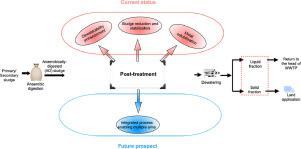Water Research ( IF 11.4 ) Pub Date : 2021-09-14 , DOI: 10.1016/j.watres.2021.117665 Zhiyao Wang 1 , Tao Liu 1 , Haoran Duan 1 , Yarong Song 1 , Xi Lu 1 , Shihu Hu 1 , Zhiguo Yuan 1 , Damien Batstone 1 , Min Zheng 1

|
Anaerobic digestion is the most commonly used sludge treatment technology in large-scale wastewater treatment plants (WWTPs), generating two main products, i.e., biogas and anaerobically digested (AD) sludge. Biogas can be used as a source of renewable energy, and AD sludge is often transported for agricultural land application. Land application of AD sludge is confronted with ever-increasing economic and regulatory pressures due to its high water content, high organic content and related odour and pathogen content (if poorly stabilized), as well as potential toxic metal and organic contaminants. To address these challenges, a number of technologies have been developed for the further treatment of AD sludge before final disposal. This review aims to critically evaluate these state-of-the-art technologies. These technologies were categorized based on their primary aims: 1) dewaterability enhancement; 2) solids reduction and stabilization; 3) toxic metals removal. At present, the goal of post-treatment mainly focuses on dewaterability enhancement, to reduce transport costs. In future, we propose that the post-treatment of AD sludge should orient towards multiple aims, i.e., an integrated approach enabling sludge volume reduction, stabilization (including pathogen removal), and metal solubilization simultaneously. Two promising technical routes are suggested as examples, i.e. physio-chemical iron-based advanced oxidation and biological acidic aerobic digestion, while more approaches need to be developed in future studies. We concluded that post-treatment of AD sludge will promote the AD sludge management towards a more economically favourable, socially acceptable, and environmentally sustainable way; however, further development and rigorous evaluation are required for a wider adoption.
中文翻译:

厌氧消化污泥的后处理选择:现状与未来展望
厌氧消化是大型污水处理厂 (WWTP) 中最常用的污泥处理技术,产生两种主要产品,即沼气和厌氧消化 (AD) 污泥。沼气可用作可再生能源,而 AD 污泥通常被运输用于农业用地。由于 AD 污泥的高含水量、高有机物含量以及相关的气味和病原体含量(如果稳定性不佳)以及潜在的有毒金属和有机污染物,其土地应用面临着不断增加的经济和监管压力。为了应对这些挑战,已经开发了许多技术来在最终处置之前对 AD 污泥进行进一步处理。本综述旨在批判性地评估这些最先进的技术。这些技术根据其主要目标进行分类: 1) 提高脱水能力;2) 固体减少和稳定;3) 有毒金属去除。目前,后处理的目标主要集中在增强脱水能力,以降低运输成本。未来,我们建议 AD 污泥的后处理应面向多个目标,即同时实现污泥减容、稳定(包括病原体去除)和金属增溶的综合方法。提出了两条有前景的技术路线,即物理化学铁基高级氧化和生物酸性好氧消化,但在未来的研究中需要开发更多的方法。我们得出的结论是,对 AD 污泥进行后处理将促进 AD 污泥管理朝着更经济的方向发展,社会可接受的和环境可持续的方式;然而,要得到更广泛的采用,还需要进一步的发展和严格的评估。











































 京公网安备 11010802027423号
京公网安备 11010802027423号